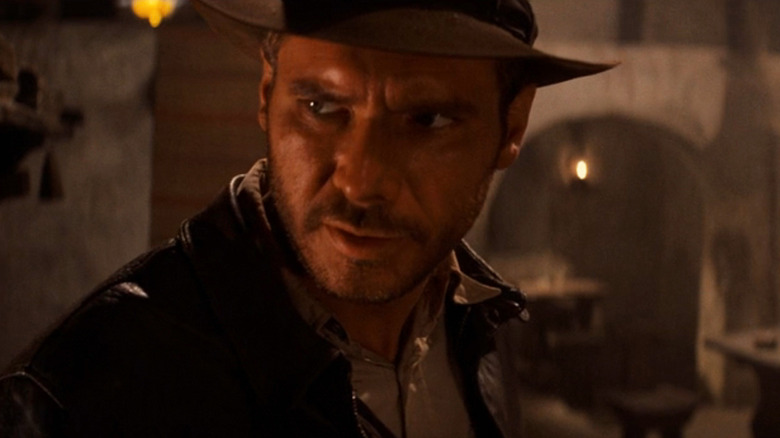Steven Spielberg Hid A Major Indiana Jones Secret From The Studio For A Good Reason
Moviemaking has come a long way from the days when John Wayne nearly perished on the set of "Noah's Ark." Back then, a pre-code Hollywood seemed to dispense with extras without a care in the world. Today, dumping tons of water on a set and leaving actors and extras to die or suffer from severe injuries would be unthinkable. But while movie sets are, in comparison to that 1920s blunder, safer than they've ever been, it took a long time for Hollywood to really buckle down and ensure the safety of its casts and crews.
Take "Raiders of the Lost Ark." Steven Spielberg's action adventure classic was filmed in 1980, a good half a century after the Duke managed to escape his brush with death on the set of "Noah's Ark." As such, you might hope that everything on the set of "Raiders" was on the up and up, but Spielberg was surprisingly reckless while making the movie. For one thing, no one on the Indiana Jones set was safe from the pythons, and even Spielberg was amazed that star Harrison Ford and his stunt team made it through production alive.
In a piece for the American Society of Cinematographers, the director once recounted how he made Ford himself outrun the 300-pound fiberglass boulder for the now legendary opening segment of the movie. "I was an idiot for letting him try it," he wrote. Clearly, then, Spielberg was in a renegade era of his career while making the inaugural Indiana Jones film, and that extended to his relationship with its studio backer, Paramount Pictures. Indeed, it seems the young filmmaker wasn't entirely honest with the company about how long it would take to shoot the film, which considering how things turned out was — unlike making Ford outrun a 300-pound boulder — probably the right choice.
Spielberg's secret Raiders of the Lost Ark schedule
When Indiana Jones creator George Lucas was originally looking for a studio to back his adventure movie, it proved difficult. The "Star Wars" director struggled to get any backing mostly due to the project's $20 million budget. Thankfully, Paramount eventually agreed, but Lucas was still trying to keep costs down and had to convince the studio that Steven Spielberg was the director for the job. Having only just helmed the critical flop that was 1979's "1941" (which even has Spielberg acknowledged went wrong), he wasn't exactly in-demand, even though the movie had been a modest box office success. Making matters worse, the comedy had come in over budget. Even after Paramount relented and Spielberg got the "Raiders" job, he was eager to prove he could make a good film without over-spending.
In his American Society of Cinematographer article, the director wrote about economical filmmaking being of the utmost importance, revealing that he "wanted to make 'Raiders' economically and make it look like $40 million and, in fact, spend only $20 million." Indeed, $20 million was the budget Paramount had agreed to, and in order to stay within that figure, Spielberg developed his own shooting schedule that he kept secret from everyone, including the studio. "The $20 million actually would pay for 87 days of shooting," he wrote, "but I had devised a second schedule of 73 days that very few people knew about — Paramount Pictures, for one.
In order to stick to his secret schedule, Spielberg developed a shooting style that involved filming a lot less takes than he typically would. Ultimately, that approach resulted in a classic movie, even if the director did endanger his crew in the process.
By the time he made Raiders, Steven Spielberg was confident in his abilities
Explaining how he managed to stick to a reduced shoot schedule of 73 days, Steven Spielberg described how he cut down on the number of takes he did for each scene. "I just found that, by not doing 15 takes on each shot, but by doing only, let's say, three to five takes, I was able to get a lot more spontaneity into the film with less self-indulgence and pretentiousness." Often, that spontaneity was spurred by forces outside Spielberg's control, such as when Harrison Ford improvised a classic "Raiders" moment because he and many members of the cast and crew had contracted a severe case of dysentery and he simply wanted to get the scene over with — which no doubt helped Spielberg keep pace with his secret schedule. The director was also reportedly averaging 35 setups a day, which was far from typical but surely further helped him in terms of staying on-schedule. In his ASC piece, he wrote:
"I didn't have a lot of time to try different things, but I think I've made enough movies that involved horrendous logistics — 'Jaws,' 'Close Encounters,' and '1941' — for me to finally receive my diploma, graduate with both honor and infamy, and get into the field where I can make a movie responsibly for a relatively medium budget that would appear to be something more expensive."
In other words, he knew he was a good director by the time he came to make "Raiders," to the extent he didn't need Paramount's blessing to reduce the schedule, or even for the execs to know how he was making the film — which, considering he almost killed its stuntmen and star, was probably for the best anyway.


